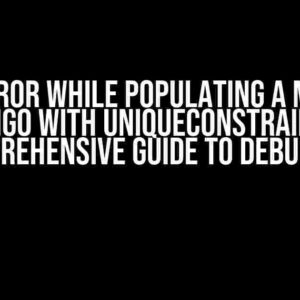Are you tired of seeing the dreaded “Duplicate class” exception in your Android AI app? You’re not alone! This frustrating error can bring your development process to a grinding halt, leaving you scratching your head and wondering what went wrong. Fear not, dear developer, for we’ve got you covered. In this comprehensive guide, we’ll take you by the hand and walk you through the troubleshooting process, ensuring that you can get back to building that AI-powered masterpiece in no time.
Understanding the Duplicate Class Exception
Before we dive into the solution, it’s essential to understand the root cause of the problem. The “Duplicate class” exception typically occurs when there are multiple classes with the same name in your project. This can happen in various scenarios:
- Multiple modules or libraries in your project contain the same class.
- You’ve accidentally added the same dependency twice in your build.gradle file.
- A library or module is using an older version of a class that’s already present in your project.
Step 1: Identify the Culprit
To fix the issue, you need to identify which class is causing the duplication. Here’s how:
- Open your Android Studio project and navigate to the
Buildmenu. - Click on
Rebuild Projectto regenerate the build files. - In the
Messageswindow, look for the error message containing the class name that’s causing the duplication. - Take note of the class name and the library or module it belongs to.
Step 2: Check for Duplicate Dependencies
One of the most common causes of the “Duplicate class” exception is duplicate dependencies in your build.gradle file. Let’s check for that:
dependencies {
implementation 'com.google.firebase:firebase-auth:21.0.1'
implementation 'com.google.firebase:firebase-auth:21.0.3'
}
In the above example, the firebase-auth dependency is listed twice with different versions. To fix this, remove the duplicate entry and keep only one version:
dependencies {
implementation 'com.google.firebase:firebase-auth:21.0.3'
}
Step 3: Investigate Library Conflicts
Sometimes, libraries or modules in your project may be using older versions of classes that are already present in your project. Let’s investigate:
| Library/Module | Class Version |
|---|---|
| com.google.android.material | 1.3.0 |
| com.example.customlibrary | 1.2.0 |
In the above example, the com.google.android.material library is using version 1.3.0 of the class, while the com.example.customlibrary is using an older version (1.2.0). To fix this, you can:
- Update the custom library to use the same version of the class as the material library.
- Exclude the conflicting class from the custom library.
Step 4: Exclude Conflicting Classes
If updating the library isn’t an option, you can exclude the conflicting class from the library. Here’s an example:
dependencies {
implementation('com.example.customlibrary:1.2.0') {
exclude group: 'com.google.android.material', module: 'material'
}
}
In the above example, we’re excluding the material module from the com.example.customlibrary. This will ensure that the class from the custom library is not used, and the one from the material library is used instead.
Step 5: Clean and Rebuild Your Project
After making the necessary changes, it’s essential to clean and rebuild your project to ensure that the changes take effect:
- Go to the
Buildmenu and click onClean Project. - Wait for the cleaning process to complete.
- Click on
Rebuild Projectto regenerate the build files.
Conclusion
The “Duplicate class” exception can be frustrating, but with these steps, you should be able to identify and fix the issue in no time. Remember to:
- Identify the culprit class and library/module.
- Check for duplicate dependencies.
- Investigate library conflicts.
- Exclude conflicting classes.
- Clean and rebuild your project.
By following these steps, you’ll be back to building your Android AI app in no time. Happy coding!
Bonus Tip: To avoid duplicate class exceptions in the future, make sure to keep your dependencies up-to-date and use a consistent versioning scheme throughout your project.
We hope this guide has been helpful in solving the “Duplicate class” exception in your Android AI app. If you have any further questions or need more assistance, feel free to ask in the comments below!
Frequently Asked Question
Got stuck with a pesky Duplicate class exception in your Android AI app? Don’t worry, we’ve got you covered!
What is a Duplicate class exception, and why is my Android AI app throwing it?
A Duplicate class exception occurs when two or more classes with the same name are trying to be loaded into the same package. This can happen if you have duplicate .jar files in your project or if you’re using multiple libraries that contain the same classes. In the case of an Android AI app, it’s likely that one of the AI libraries or dependencies is causing the conflict.
How do I identify which class is causing the Duplicate class exception?
To identify the problematic class, check the error message for the class name that’s being duplicated. If that doesn’t give you a clear answer, try using the `gradle dependencies` command in your terminal to see a list of all the dependencies in your project. You can also use tools like Classyshark or Jar Explorer to inspect the contents of your .jar files and identify duplicates.
How do I fix the Duplicate class exception by excluding a class from a dependency?
To exclude a class from a dependency, you can use the `exclude` keyword in your build.gradle file. For example, if you want to exclude the ‘com.example.ClassName’ class from the ‘com.example:library:1.0’ dependency, you can add the following code: `implementation(‘com.example:library:1.0’) { exclude group: ‘com.example’, module: ‘ClassName’ }`. This will prevent the class from being included in your project and resolve the Duplicate class exception.
Can I fix the Duplicate class exception by using a different version of a dependency?
Yes, sometimes the Duplicate class exception can be resolved by using a different version of a dependency. Check the documentation of the dependency to see if there’s a version that’s compatible with your project. You can also try using the `force` keyword in your build.gradle file to force the use of a specific version. For example: `implementation(‘com.example:library:1.0.1’) { force = true }`. This can help resolve the conflict by ensuring that only one version of the class is included in your project.
What if I’m still stuck with the Duplicate class exception after trying the above solutions?
If none of the above solutions work, it’s time to get your detective hat on and do some more digging! Try cleaning and rebuilding your project, checking for any typos in your build.gradle file, or searching online for solutions specific to your project’s configuration. If all else fails, consider seeking help from the Android developer community or a professional developer who can help you troubleshoot the issue.




![Solving the Debian > [CXX1429] Error: A Step-by-Step Guide for Android Developers Solving the Debian > [CXX1429] Error: A Step-by-Step Guide for Android Developers](https://chesea.hkhazo.biz.id/wp-content/uploads/sites/682/2024/07/solving-the-debian-cxx1429-error-a-step-by-step-guide-for-android-developers-with-text-300x300.jpg)